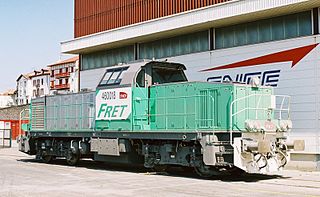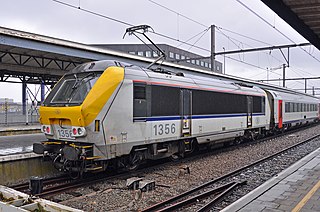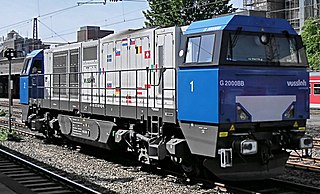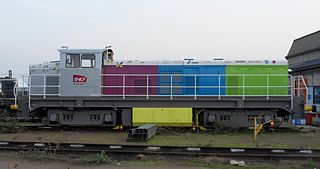
An electro-diesel locomotive is a type of locomotive that can be powered either from an electricity supply or by using the onboard diesel engine. For the most part, these locomotives are built to serve regional, niche markets with a very specific purpose.

SM42 is the PKP class for a Polish shunter diesel locomotive for shunting and light freight traffic, built by Fablok in Chrzanów.

Alstom Traxx is a modular product platform of mainline diesel-electric and electric locomotives. It was produced originally by Bombardier Transportation and later Alstom, and was built in both freight and passenger variants. The first version was a dual-voltage AC locomotive built for German railways from the year 2000. Later types included DC versions, as well as quadruple-voltage machines, able to operate on most European electrification schemes: 1.5/3.0 kV DC and 15/25 kV AC. The family was expanded in 2006 to include diesel-powered versions. Elements common to all variants include steel bodyshells, two bogies with two powered axles each, three-phase asynchronous induction motors, cooling exhausts on the roof edges, and wheel disc brakes.
A hybrid train is a locomotive, railcar or train that uses an onboard rechargeable energy storage system (RESS), placed between the power source and the traction transmission system connected to the wheels. Since most diesel locomotives are diesel-electric, they have all the components of a series hybrid transmission except the storage battery, making this a relatively simple prospect.

The SNCF Class BB 60000 are a class of 4 axle heavy shunting and light freight diesel–electric locomotives built at the Vossloh España works in Valencia. Since the class is primarily used as a freight locomotive the class is commonly referred to as SNCF BB 460000.

The Class 13 are a type of mixed use 200 km/h (124 mph) multivoltage electric locomotive of type Traxis designed by Alstom in the late 1990s for the Belgian and Luxembourgish railways.

The SNCF Class BB 36000 locomotives are a class of triple voltage 4 axle twin bogie electric locomotives built by GEC-Alsthom between 1996 and 2001 for SNCF.

The Voith Gravita locomotives are a family of road switcher diesel-hydraulic locomotives built by Voith Turbo Lokomotivtechnik GmbH & Co. KG. Available in a range of configurations from 4 to 6 axles, they are designed for shunting and light and medium freight operations.

The Prima Diesel-electric locomotives are a class of medium and heavy, four- and six-axle, passenger and freight mainline locomotives. They have been built both to 1,435 mm standard and 1,668 mm broad gauges, and find use in the Middle East, Europe and North America. Alstom is the primary designer in cooperation with both General Motors and Siemens.

The SNCF BB 75000 are 4 axle, Bo′Bo′, diesel electric locomotives ordered in 2000 by SNCF for freight operations to renew its aging fleet.

The Eurorunner family of locomotives are a series of medium- to high-power diesel-electric locomotives built by Siemens for the European market. Introduced from 2002 onwards, they share design characteristics with the successful Eurosprinter range of electric locomotives, also built by Siemens.

The G 2000 BB is a four axle heavy shunting and mainline locomotive, designed by German company Vossloh and built at the former MaK plant in Kiel. At the time of its introduction in 2000 it was the most powerful hydraulic transmission locomotive in Vossloh's range.

The Vossloh G1206 is a B'B' diesel hydraulic freight locomotive built in Kiel and used by several European railway operators including a SNCF specific variant the BB 461000 series.

The AD43C is a type of mainline 6 axle Co'Co' diesel locomotive designed by Alstom and used by the Islamic Republic of Iran Railways (RAI). It was in production from 2000. Delivery started in 2002.

The Vossloh G1700 BB is a four axle B′B′ medium power diesel-hydraulic locomotive manufactured by Vossloh Locomotives GmbH. in Kiel.

Metrans Rail s.r.o. is a Czech railway operator. It operates regular freight trains connecting container terminal of its parent Metrans in Prague-Uhříněves with Rotterdam. It is presently a wholly-owned subsidiary of the German logistics company HHLA.

The Stadler Euro Dual is a series of dual power, electro-diesel locomotive by Stadler Rail Valencia. Unlike traditional dual mode locomotives, fitted with relatively low-powered diesel engines for 'last mile' movements only, vehicles are typically furnished with power units more comparable to that of mainline diesel locomotives.

BB 63413 PLATHEE is a hybrid locomotive that was used for testing on the French rail operator SNCF. PLATHEE is an acronym for "Platform for Energy- Efficient and Environmentally Friendly Hybrid Trains".

The Indian locomotive class WAG-12B is a class of 25 kV AC electric locomotives that was developed in 2017 by Alstom with technological collaboration with Indian Railways. The model name stands for wide gauge(W), Alternating Current (A), Goods traffic (G) locomotive-12 . They entered trial service in 2019. A total of 370 WAG-12B have been built at Electric Locomotive Factory, Madhepura, Bihar, India.
The British Rail Class 18 is a class of hybrid locomotives designed and built by the British railway locomotive manufacturer Clayton Equipment Company in Burton upon Trent, Staffordshire. It has also been referred to as the CBD90 Hybrid+ by Clayton and private railway customers.





















